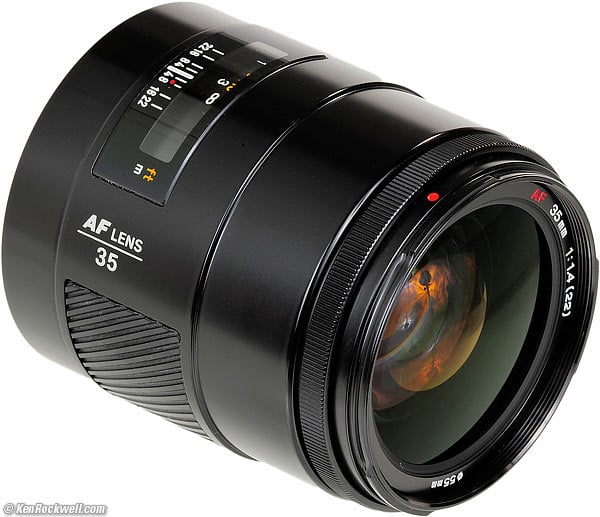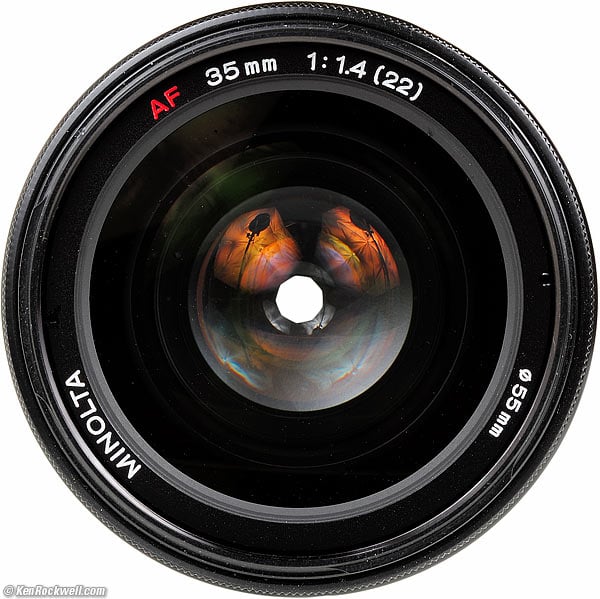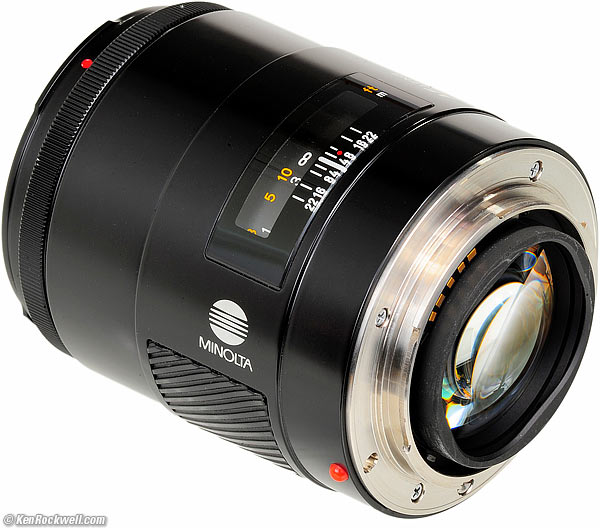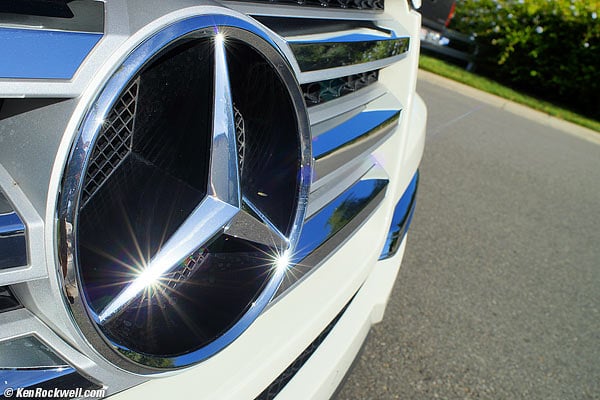Home Donate New Search Gallery Reviews How-To Books Links Workshops About Contact
Minolta 35mm f/1.4
Full-Frame
for MAXXUM and Sony (1987-today)
World's first aspherical wide angle lens
World's first super-speed AF wide lens
World's first rear-focus lens
World's first aspherical AF lens
© 2013 KenRockwell.com. All rights reserved.
Intro Specifications Performance Compared Recommendations
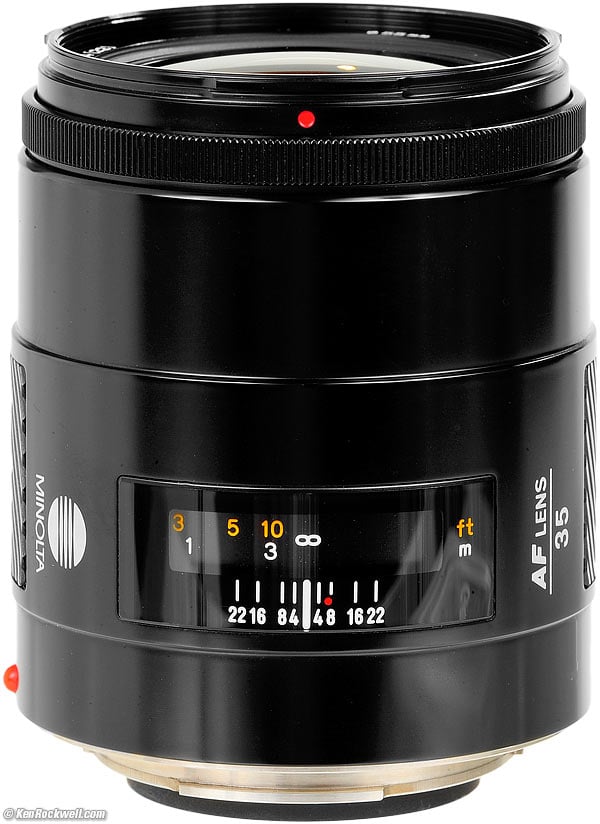
Minolta MAXXUM AF 35mm f/1.4 (metal 55mm filter thread, 16.6 oz./469g, 1'/0.3m close focus, about $800 used or $1,500 new at Amazon or at Adorama. My biggest source of support is when you use this link directly to them at eBay (How to Win at eBay) and to them at Amazon or at at Adorama, or use any of these links when you get anything, regardless of the country in which you live. Please always use these links when getting any of your gear so I can continue to share what I know for free — but I receive nothing for my efforts if you buy elsewhere. I'm not NPR; I get no government hand-outs and run no pledge drives to support my research, so please always use any of these links for the best prices and service whenever you get anything. Thanks for helping me help you! Ken.
October 2013 Minolta Minolta Lenses Sony Pentax Nikon Canon more
Why Fixed Lenses Take Better Pictures.
Palm, 01 October 2013. Sony A99 at 10 MP, Maxxum AF 35mm f/1.4 at f/8, 1/125 at ISO 100. Full resolution.
Introduction top
Intro Specifications Performance Compared Recommendations
The Minolta Maxxum AF 35mm f/1.4 is an extremely high-performance and very well made normal-to-wide lens for all Minolta MAXXUM and Sony Alpha cameras.
This Minolta 35 1.4 is a superb lens today, and was an absolutely spectacular lens beyond anything ever seen from LEICA, Nikon or Canon when it was introduced, and none of these brands had anything comparable for years afterwards. The reason so few people have ever heard of this professional lens is because it was introduced by Minolta, which wasn't a brand used by professionals. Pros don't shoot Minolta, and Minolta shooters didn't want to pay for this pro lens.
This Minolta Maxxum AF 35mm f/1.4 set so many world's-first records that it took decades for other makers to catch up:
This is the world's first internal (rear) focusing camera lens.
This is the world's first aspherical wide-angle SLR lens.
This is the world's first autofocusing super-speed wide lens.
This is the world's first aspherical autofocus lens.
As an aspherical rear-focusing ultraspeed wide-angle lens, it far exceeded the performance of LEICA's conventional SUMMILUX 35mm f/1.4 of the time. LEICA didn't make an aspherical 35/1.4 copy until 1990, and didn't copy the floating elements until 2010. LEICA still doesn't make an internal focusing 35/1.4; LEICA's newest still moves in and out as focused.
This groundbreaking Minolta 35/1.4 far exceeds the performance of Nikon's 35/1.4, which is only a manual focus lens. Nikon never caught up with any kind of autofocus 35/1.4 until 2010, which also copied the aspherical rear-focusing deign of this lens from 23 years before. Nikon's newest AF 35/1.4 is OK, but mostly plastic, not solid alloy as is this Minolta MAXXUM masterpiece. I returned my Nikon AF 35/1.4 when I realized it had a plastic filter thread, not metal like all the other brands.
Canon's EF 35/1.4 L is a great AF aspherical rear-focus lens. It only took Canon 12 years to copy this Minolta lens in 1998, and today is still one of Canon's most popular lenses.
On today's Canon and Nikon lenses you may move the focus ring at any time for instant manual-focus override, while this classic Minolta lens requires you to move the AF-MF switch on the camera to swap between modes. You may not turn this Minolta's focus ring while in AF mode, in which it turns by itself as autofocused.
Used on today's Sony A99, this 1980s Minolta AF 35/1.4 lens has image stabilization and very fast autofocus.
This Minolta 35mm f/1.4 works perfectly on today's Sony A99, except that the AF-D Depth Map AF (whatever that is) and the automatic lens corrections don't work. So what, the images look fantastic and everything else works, like face recognition and all the focus modes including Direct Manual Focus (DMF) override, so all is well.
This original Minolta lens is a marvel of precision, far better made than the plasticy garbage Sony sells today. This Minolta lens has a super-smooth and precise focus helicoid, metal filter thread and hood mount, metal focus ring and even an all-metal barrel.
This is a full-frame lens for 35mm film and full-frame digital, and will be reviewed thusly. Feel free to use this on cropped-frame cameras, too, on which it will give even closer-cropped results.
Minolta Maxxum AF 35mm f/1.4. enlarge.
History
This groundbreaking lens' optics are still the same today after 27 years. Only the outer cosmetics and quality of barrel materials has changed. I may have missed some versions here; it doesn't matter: they are all the same lens.
1987-1998
This version is the world's first.
It was introduced in 1987, 2 years after the first Minolta MAXXUM 7000.
1998-2006
Minolta added a rubber focus ring, a focus lock button and a gold-colored ring and a "G" to the name in 1998 for marketing purposes.
It has exactly the same optics.
I don't know if the barrel is still solid alloy.
2006-today
Sony bought Minolta in 2006, and still sells the same lens branded as Sony.
Specifications top
Intro Specifications Performance Compared Recommendations
Name top
Minolta calls this the MAXXUM AF 35mm f/1.4 (22).
MAXXUM is Minolta's autofocus brand, called Dynax outside the US.
The (22) is the smallest f/stop.
Optics top
10 elements in 8 groups.
One aspherical element.
Rear focusing; nothing except the focus ring moves externally as focused.
Multicoated mostly in magenta and green.
Diaphragm top
Minolta 35mm f/1.4 at about f/5.6. bigger.
9 rounded blades.
Stops down to f/22.
Circular to f/2.8.
Nonagonal from f/4 to f/22.
Coverage top
35mm film, full-frame and smaller format digital.
Focal Length top
35mm.
When used on an APS-C style camera, sees an angle of view similar to what a 50mm lens sees when used on a full-frame or 35mm camera.
Angle of View top
63.4º on full-frame.
Close Focus top
1 foot (0.3 meters) from the image plane.
Maximum Reproduction Ratio top
1:5 (0.2x life size).
Hard Infinity Focus Stop? top
Yes.
This is great for astronomy; just turn to the stop and you have fixed laboratory-perfect focus all night.
Focus Scale top
Yes.
Depth-of-Field Scale top
Yes.
Infra-Red Focus Index top
Yes, but not on newer versions.
Aperture Ring top
No.
Filter Thread top
55mm.
Solid alloy.
Does not move.
Size top
2.50" (63.5mm) diameter by 3.0 " (76mm) extension from flange.
It does not change size as focused.
Weight top
16.555 oz. (469.3g), actual measured.
Minolta specifies 16.6 oz. (470g).
Hood top
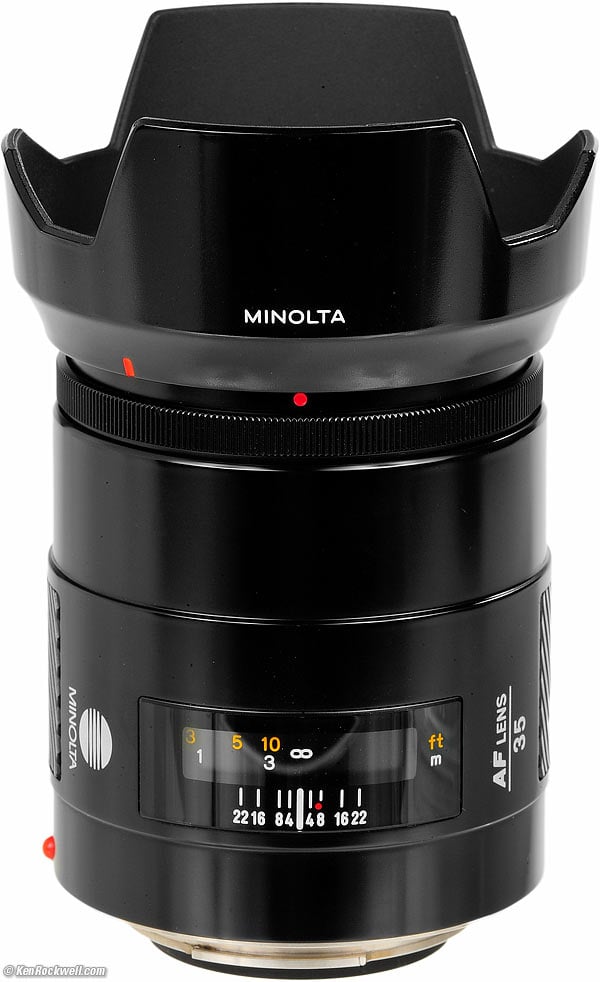
Minolta 35mm f/1.4 with hood.
Plastic bayonet hood included.
Marked for 35/1.4, and is identical except for markings to the hood for the 28/2 and 35/2!
Caps top
55mm snap-in front cap and standard MAXXUM rear cap, black.
Quality top
Made in Japan.
Minolta Product Number top
25911, later 2666118.
Sony number SAL35F14G.
Price, USA top
November 2013: About $800 used (How to Win at eBay).
June 2013: About $950 used.
Performance top
Intro Specifications Performance Compared Recommendations
Distortion Ergonomics Falloff Filters
Flash Exposure Focus Breathing Ghosts
Hood Lateral Color Fringes Macro Mechanics
Sharpness Spherochromatism Sunstars Survivability
Overall performance top
The Minolta 35mm f/1.4 has great optics in a better package than Nikon's newest professional lenses today.
It works great on an original 1985 MAXXUM 7000 or the newest 2013 Sony A99.
Today in 2013, it is still a fantastic lens. Today's designs aren't much different, and aren't significantly better — other makers just took decades to get back to where Minolta was in 1987.
Autofocus performance top
AF Speed
AF speed is ultra-fast on a 2013 Sony A99, and fast on a 1985 Minolta MAXXUM 7000.
One full turn (two half-turns) of the AF screw brings it from infinity down to 2.5 feet.
AF Accuracy
On the Sony A99, focus is always dead-nuts on at f/1.4; I don't need any AF fine-tuning.
Manual Focus
Manual focus is perfect: smooth and precise. The thin metal focus ring might be a little harder to find at first, compared to newer lenses.
You have to move the AF-MF switch on the camera to swap between modes. You may not turn the ring while in AF mode, in which it turns by itself as autofocused.
A 130º turn of the focus ring brings you from infinity to 1 foot (0.3m).
Bokeh performance top
Dada and Sasha. (22 June 2013, 7:51 PM, cropped from Sony A99, Sony flash, Minolta 35mm f/1.4, f/4 at 1/60 at ISO 320, Athentech Perfectly Clear plug-in.) bigger.
Palms at f/1.4, June 2013. bigger.
Bokeh, the character of out of focus backgrounds, not simply how far out of focus they are, is fair at f/1.4 and neutral at smaller apertures.
Coma performance top
Coma is common in fast wide lenses. It is when points of light turn into weird shapes in the corners, and contributes to the corners blurring at large apertures.
This aspheric lens has just a tiny bit of coma on full-frame at f/1.4.
Distortion performance top
The Minolta 35mm f/1.4 has moderate barrel distortion.
I can be corrected by using these factors in Photoshop's lens distortion filter:
On full-frame |
|
∞ |
+2.4 |
10' (3m) |
+1.2* |
© 2013 KenRockwell.com. All rights reserved.
* Some waviness remains.
Ergonomics (handling and ease-of-use) performance top
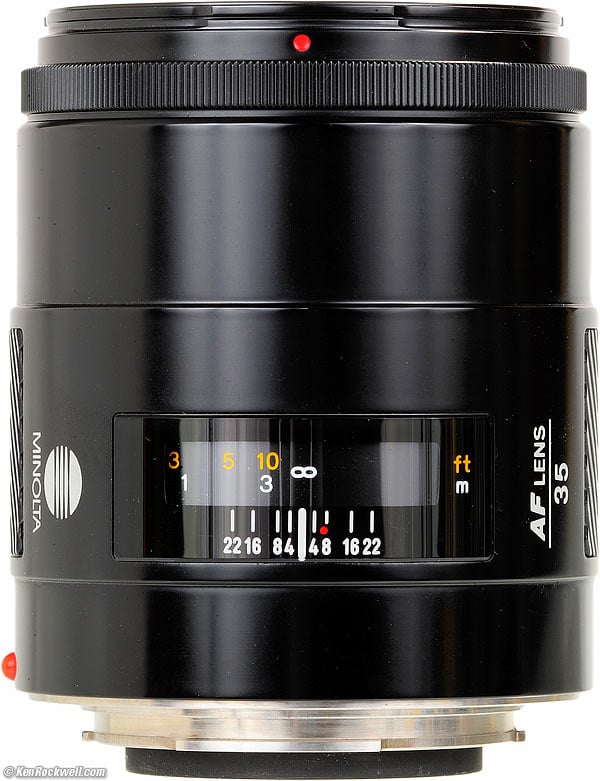
Minolta 35mm f/1.4.
Ergonomics are easy; the whole lens is a big metal handle for mounting and unmounting.
For shooting, the entire metal barrel is grip.
The manual focus ring is the little ribbed metal ring on front. Nothing else moves. Swapping between auto and manual focus requires moving a switch on the camera, or maybe using the Sony A99's DMF mode, any of which can be a big pain depending on your camera. There is no instant manual-focus override in the lens itself.
Falloff (darkened corners) performance top
Falloff on FX and 35mm is visible at f/1.4, and gone otherwise. It will be even less of an issue on APS-C type cameras.
The Shading Correction in the Sony A99 probably doesn't recognize this lens; I leave it OFF.
I've exaggerated the falloff by shooting a gray field and placing these on a gray background.
Minolta AF 35mm f/1.4 falloff on full frame and 35mm, no correction:
© 2013 KenRockwell.com. All rights reserved.
|
Filters, use with performance top
There is no problem with vignetting on full-frame with any normal filter, or even two stacked filters.
The filter ring doesn't move.
Flash Exposure performance top
Dada and Sasha. (22 June 2013, 7:51 PM, cropped from Sony A99, Sony flash, Minolta 35mm f/1.4, f/4
This original 1985 Minolta MAXXUM AF 35 1.4 gives great exposure with flash.
Focus Breathing performance top
Of interest mostly to cinematographers focusing back and forth between two subjects, the image gets bigger as focused more closely.
Flare and Ghosts performance top
Ghosts are no problem with this multicoated lens, even on the complex Sony A99 which has all sorts of internal mirrors in the optical shooting shooting path.
Here's looking directly into the disk of the sun, which was blinding in person:

Minolta 35mm f/1.4 at f/8.
If you go out of your way, on rare occasions I can get one blob opposite the sun if conditions are just right.
Hood performance top
There is a hood available, but I wouldn't use it; it doesn't do much.
The hood is the same as the hood sold for the 28mm f/2 and 35mm f/2. They differ only in their printed markings!
Lateral Color Fringes performance top
There are no lateral color fringes visible on an uncorrected Sony A99 at 24 MP.
There is secondary axial chromatic aberration (a different aberration) visible at f/1.4: you may see slight green and magenta fringes throughout the entire image even if you're in perfect focus at f/1.4.
Macro performance top
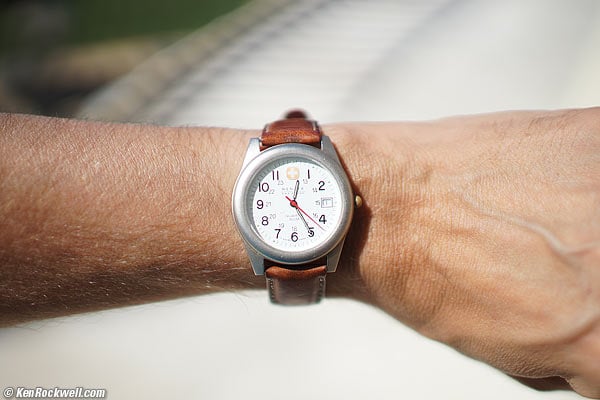
On full-frame at closest focus distance at f/1.4.
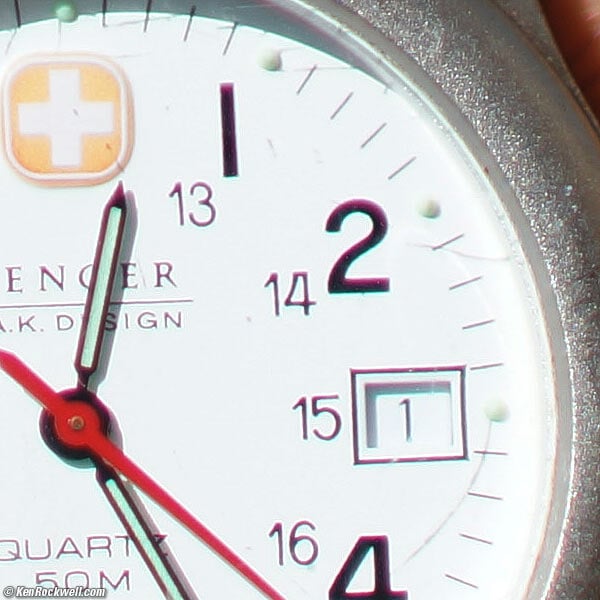
Crop from above 24MP image at 100%. If this is 6" (15cm) here and you printed the entire image at this same high magnification, the print would be 40 x 60" (1 x 1.5 meters)!
The magenta and green fringes are from axial chromatic aberration These wouldn't be visible if this lens wasn't so sharp at f/1.4.
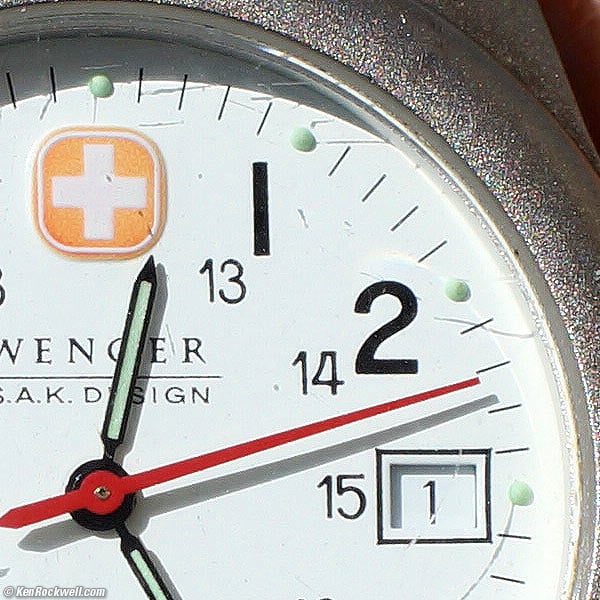
Crop from same 24MP image at 100% at f/8. If this is 6" (15cm) here and you printed the entire image at this same high magnification, the print would be 40 x 60" (1 x 1.5 meters)!
The axial chromatic aberration goes away as stopped down.
If you want macro, either of the Minolta MAXXUM AF 50mm f/2.8 Macro or Minolta MAXXUM AF 100mm f/2.8 Macro get much closer and are even sharper.
Mechanics and Construction performance top
Rear, Minolta 35mm f/1.4. enlarge.
In action to outstanding optics, the Minolta 35mm f/1.4 is all metal, a real lens instead of the disposable plastic garbage churned out today.
Filter Threads, Hood Mount and Forebarrel
Solid alloy.
Identity Ring
Solid alloy.
Engraved and filled with two colors of paint.
Minolta is proud of this masterpiece!
Focus Ring
Solid alloy.
Barrel Exterior
Alloy, rubber covered.
Depth-of-Field Scale
Yes.
Aperture Ring
None.
Mount
Chromed metal.
Barrel Markings
Paint.
Mounting Index Dot
Red plastic ball.
Serial Number
Engraved into bottom of barrel and filled with white paint.
Moisture seal at mount
No.
Noises When Shaken
Mild clicking.
Made in
Japan.
Sharpness performance top
Image sharpness depends more on you than your lens, and lens sharpness doesn't mean much to good photographers.
The MAXXUM 35mm F1.4 is super sharp, but a little less sharp in the full-frame corners wide-open.
As shot on the full-frame 24MP Sony A99 on the test range at infinity:
f/1.4
Perfectly sharp and contrasty in the center, although a little bit of secondary axial chromatic aberration may show slight green-magenta fringes on contrasty edges. Nikon's ED or Canon's UD glass would solve this.
In last two millimeters of full-frame corners, coma makes them a little bit less sharp. They are dark from falloff, so no worries: you'll probably never notice.
f/2
Perfectly sharp and contrasty in the center.
The last two millimeters of the corners of full frame are still a little bit less sharp; about the same as at f/1.4, but now less dark.
f/2.8
Perfectly sharp and contrasty in the center.
The last two millimeters of the corners of full frame are still a little bit less sharp, and since they are now as bright as the rest of the frame, you might notice it for test shots.
f/4
Perfectly sharp and contrasty in the center.
Full-frame corners are almost perfect, all the way out to the end.
f/5.6
The center is perfect, and the corners are just about perfect, too.
f/8
Everything's perfect.
f/11
Everything's perfect.
f/16
Diffraction starts to dull the image at f/16.
f/22
Even softer from more diffraction.
This is a law of physics, not a lens limitation.
Spherochromatism performance top
Spherochromatism, sometimes mistakenly called "color bokeh" by laymen, is a minor aberration which can add slight color fringes to out-of focus highlights in fast or long lenses.
While I saw axial chromatic aberration, I didn't see any spherochromatism in the Minolta 35/1.4. Out-of-focus highlights have uncolored edges; it's in-focus contrasty things that might exhibit slight green-magenta fringes, but only at f/1.4.
Sunstars performance top

Wimpy sunstar at f/8. bigger.
The circular diaphragm does nothing at large apertures, but by the smaller apertures of f/11 and smaller, the 9-bladed diaphragm makes great 18-pointed sunstars:
Sunstars on the Star at f/16.
Survivability performance top
This Minolta 35mm f/1.4 is from 1987, as tested today in 2013. After 26 years, it still looks and works like new.
It has no motors and no encoders. There is nothing critical to go wrong that a good repairman can't fix. The only electronics are a ROM chip that should not wear out unless you go doing something stupid, like trying to take it apart. It uses real lead solder, so it ought to be good for a lifetime.
It is perfectly normal for the rubber focus ring or barrel grip to turn white from lack of use. The whiteness rubs off with use; a white looking barrel means a lens that hasn't been used much.
Therefore unlike many newer lenses today, this 35/1.4 AF ought to last last for plenty of more decades of great pictures.
Compared top
Intro Specifications Performance Compared Recommendations
I prefer this version to newer ones because it feels like a real lens, and costs half as much used. I don't know if newer ones also have metal barrels, or just junky plastic.
Newer ones will have an AF-lock button on the lens, which can be very handy.
Nikon and Canon's fast 35mm lenses have similar optical performance, all of which is excellent.
For Minolta or Sony, this is the lens to get. The Minolta 35mm f/2 doesn't sell for much less, and this lens is a tad better optically. Both are excellent. Minolta's 28mm f/2 is very good optically, but not quite as good as this 35/1.4.
Recommendations top
Intro Specifications Performance Compared Recommendations
I bought this Minolta 35mm f/1.4 for dim-light work with my 1985 Minolta MAXXUM and Sony Alpha cameras. It's also wonderful for daylight use, but a zoom is handier if you don't need f/1.4.
Use the aperture-priority mode on the Sony A99 and most Sonys. Sonys have defective programming that rarely shoots wider than f/4 in Program mode, completely wasting the whole point of this lens in dim light.
There is no reason to buy anything newer, unless you want an on-lens focus lock. Spend more money if you want, but you won't be able to make any better pictures with any other 35mm lens.
If you've found the time, effort and expense I incur researching and sharing all this information for free, this free website's biggest source of support is when you use this link directly to them at eBay as I did (How to Win at eBay) or to them new at Amazon or at Adorama, or use or any of these links when you get anything, regardless of the country in which you live. Please always use these links when getting any of your gear so I can continue to share what I know for free — because I receive nothing for my efforts if you buy elsewhere. I'm not NPR; I don't get any government grants or have annoying fund drives to help me research and give all this information away for free.
Thanks for your support!
Ken.
Help me help you top
I support my growing family through this website, as crazy as it might seem.
The biggest help is when you use any of these links when you get anything, regardless of the country in which you live. It costs you nothing, and is this site's, and thus my family's, biggest source of support. These places have the best prices and service, which is why I've used them since before this website existed. I recommend them all personally.
If you find this page as helpful as a book you might have had to buy or a workshop you may have had to take, feel free to help me continue helping everyone.
If you've gotten your gear through one of my links or helped otherwise, you're family. It's great people like you who allow me to keep adding to this site full-time. Thanks!
If you haven't helped yet, please do, and consider helping me with a gift of $5.00.
As this page is copyrighted and formally registered, it is unlawful to make copies, especially in the form of printouts for personal use. If you wish to make a printout for personal use, you are granted one-time permission only if you PayPal me $5.00 per printout or part thereof. Thank you!
Thanks for reading!
Mr. & Mrs. Ken Rockwell, Ryan and Katie.
Home Donate New Search Gallery Reviews How-To Books Links Workshops About Contact




